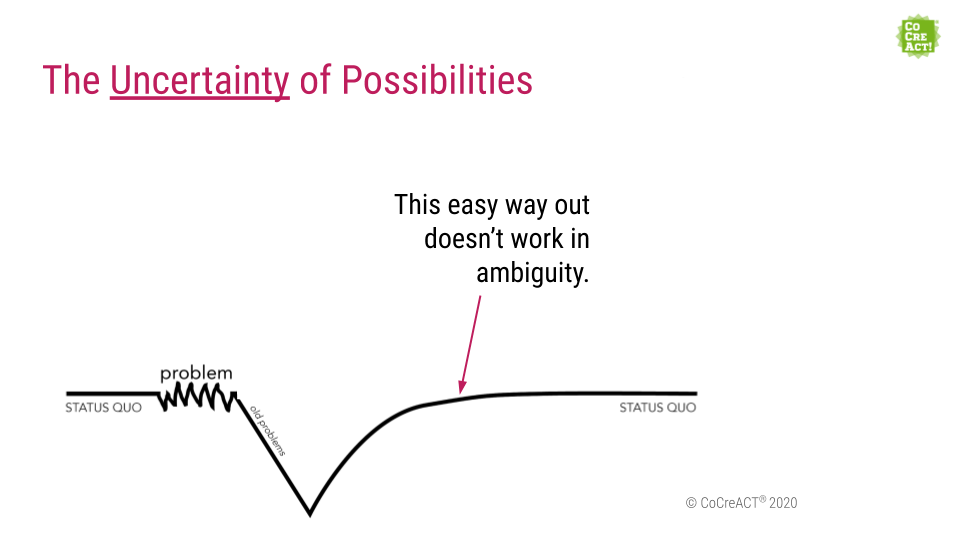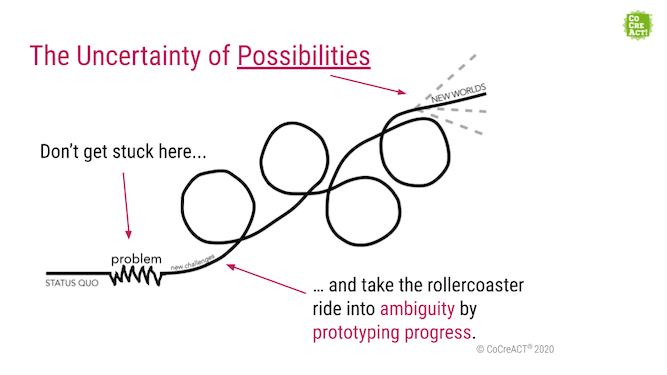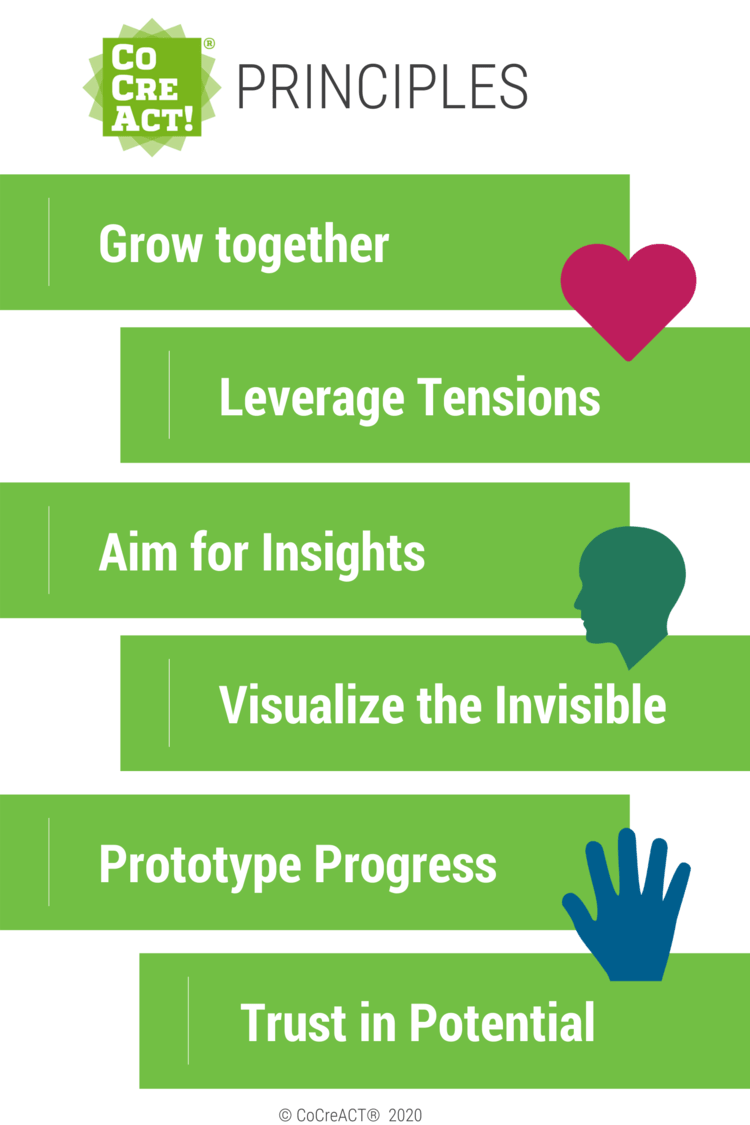Navigating Ambiguity (5/6): Prototype Progress
This is the 5th of a six-part series on our approach to navigating ambiguity based on six principles. Please find the others here.
Oh the coziness of the world that we know, where we do business as usual, where we can make plans. We can just follow the rules and act according to established norms and procedures. But once the status quo is threatened and ambiguity rises, this clarity dissipates. In uncertainty, big plans don’t help us. There is no map for uncharted territory. We can’t predict the future, we have to co-create it. We can’t rely on how things used to be done, we have to find new ways. The possibilities hidden in uncertainty can only be uncovered if we stay open for discoveries. Creativity and flexibility are the key skills to achieve progress.
Prototyping progress means evolving through learning and experimenting and creating our path forward guided by a strong, shared vision. This vision has to be sustainable enough in a complex environment. It should be bold, but also adaptable enough so that we might change it thanks to constant experimenting and validated learning. Great inventions begin as an idea that go through many experiments. Since ambiguity is always increased by complexity it’s helpful to test our thinking in context, together with others. Diversity in opinions adds to the resilience of our potential solution, especially in uncertainty.
Even when our world is shifting it is possible to avoid stagnation and capitalize on opportunities. That is why in our experience prototyping progress is especially important in uncertainty. However, we often try to escape this uncomfortable feeling with things that we believe make us feel better, more comfortable, more familiar.
Here are three common examples of self-soothing behaviours that prevent progress in ambiguous situations:
1. Need for closure as a sign for low tolerance of ambiguity
We crave certainty. As soon as something is unpredictable we seek a solution that gets us out of there. Fast! Actionism trumps activism. As long as we are busy, we feel like we are in control. We make rash decisions to escape the situation that creates pressure. Our need for closure makes the easy way out quite appealing. And the stronger our need for closure, the lower our tolerance of ambiguity.
Of course, ambiguity is hard and uncomfortable and we naturally want to avoid that. But in doing so, we risk missing the new potential that this change offers us. You can resist this need for closure! Try to hang in there and get comfortable. When we learn to restrain ourselves from the quick, easy way out, we develop our capacity to embrace our uncertainty, and to see new connections and multiple possibilities. If we can manage that, we can transform the unknown into opportunities.
2. Perfectionism as procrastination
Perfectionism is a common, and often subconscious, excuse for not getting started. Like actionsim, overthinking is not helpful. We hope for THE ONE right solution which would be nice to have, but is a bit like a Fata Morgana. There is no big aha or genius moment that relieves us from doing the work. We can’t stay hidden and tinker in our basement forever until we’re sure we got it right because the world moves on without us.
In ambiguity we need to explore our options, not narrow them down. While high hopes and aspirations guide us forward and give us direction, we can only iterate forward and test the new waters step-by-step. If we want to keep up, we keep our options open by exploring the possibilities. Quick experiments and failure along the way are crucial for insights and discoveries. We get to check assumptions and challenge what we think is certain. Accepting our uncertainty and the willingness to fail will enable us to think forward and make better decisions. If you really want to procrastinate, you can hack yourself by incubating ideas about evolving prototypes…
3. Creativity as vanity
The other enemy of progress can be creativity itself. To be clear: we are BIG fans of creativity, but we also recognize that it can generate cognitive obstacles. Creativity can be simply defined as “creating something new that is useful” (Moe Stein). Notice this definition has two parts: new and useful. Sometimes, when we focus too much on the NEW we ignore the USEFUL. There arrives a point in every creative process when we have to commit to an idea and take it further. “It doesn’t have to be perfect, just good enough to move on.” (Thanks to whoever came up with our creative battle cry!)
We narrow down our big creative ideas into the earliest testable product, as Henrik Kniberg defined so beautifully. We take it for a spin and test it with people in order to learn from honest feedback. For some, this crucial step of testing ideas may feel risky (“wait, we were having fun with that big inspiring idea!”). This can produce feelings of defensiveness (“What do you know? Of course it’s a good idea!”) and overprotective (“I am not sharing this precious idea with anyone else!)
The simple truth is that the big fun idea isn’t “precious”, and we can’t harm it with negativity. Instead, feedback, when solicited well, will make it much stronger. It’s dangerous to fall in love with our ideas and shy away from criticism. When doing so, we resort to “pitching” or “selling” them because we want to convince others of our creative genius. This is about the creative WORK of separating our sense of self from the success of an idea. Creative vanity impedes the potential to learn through feedback. We can use feedback as an opportunity to leverage tensions that may arise from criticism and to aim for insights. And yes, sometimes this demands creative courage (you can do it!) and may feel like a rollercoaster ride, but we promise: You can learn and enjoy it. This exhilaration for finding the big possibilities is what we call Ambiguity Activism.
No excuses
The moral of the story is this: Aim high, and start small with iterative steps for evolution. Don’t shy away when it gets uncomfortable. Get curious and look for the possibilities! And, in case you are wondering, we do take our own medicine. We practice this principle every day both professionally and personally.
As you may imagine, developing a model for navigating ambiguity is also an ambiguous endeavor, especially when the two key collaborators (Katrin and Tamara) are on different continents. We launched the CoCreACT® process and its training in 2015, and then in 2018 decided to incorporate “ambiguity as a skill” into our approach. Earlier this year, ambiguity punched us square in the face in the form of COVID-19. The extreme uncertainty of the corona crisis sped up our progress immensely as we quickly pursued ideas and iterated. In March we created the CoCreACT® community which supports us in prototyping progress. Over the last few months, thanks to the valuable feedback from this community, we have carved out a new series of competencies for ambiguity activism, “Leading in Ambiguity”. We take small steps, turn every iteration into a new testable offering and learn so much every single day. Every online event is an experiment, every feedback generates valuable insight. We are grateful for our community with whom we grow together and come closer to our vision of empowering others to embrace ambiguity.
Next week you can join us again and read the final post in this series where we introduce the 6th CoCreACT® principle, Trust in Potential.
If you’ve missed our introduction about our principles to navigate ambiguity, please continue reading...
WHY PRINCIPLES TO NAVIGATE AMBIGUITY?
CoCreACT® Principles
Now more than ever we need to adopt new ways of being. We need to find simple and powerful approaches to ambiguity that reveal the possibilities of new worlds. The key pillars of ambiguity activism that we outline in our CoCreACT® approach aim to do precisely that:
Co - new ways of feeling: We are in this together. Shared purpose gives us strength and direction and connection. Owning our collective uncertainty inspires us to deeper understanding and new perspectives.
Cre - new ways of thinking: In the unknown, our understanding and imagination must have fertile space to grow so that we can co-create new knowledge and solutions. This is only possible when we are able to communicate the ambiguous in experiential ways that foster compassion and creativity.
Act - new ways of doing: Trailblazing does not follow a straight and predetermined path, so we prototype forward. Our progress comes from iterative cycles of experimenting and learning. We can’t evolve through control, but through lifting each other up and being better together than we could ever be alone.
Developing an ambiguity activist mindset requires feeling, thinking, and doing in new ways. To illuminate the path forward, we have developed six essential principles for finding the big possibilities in ambiguity.






